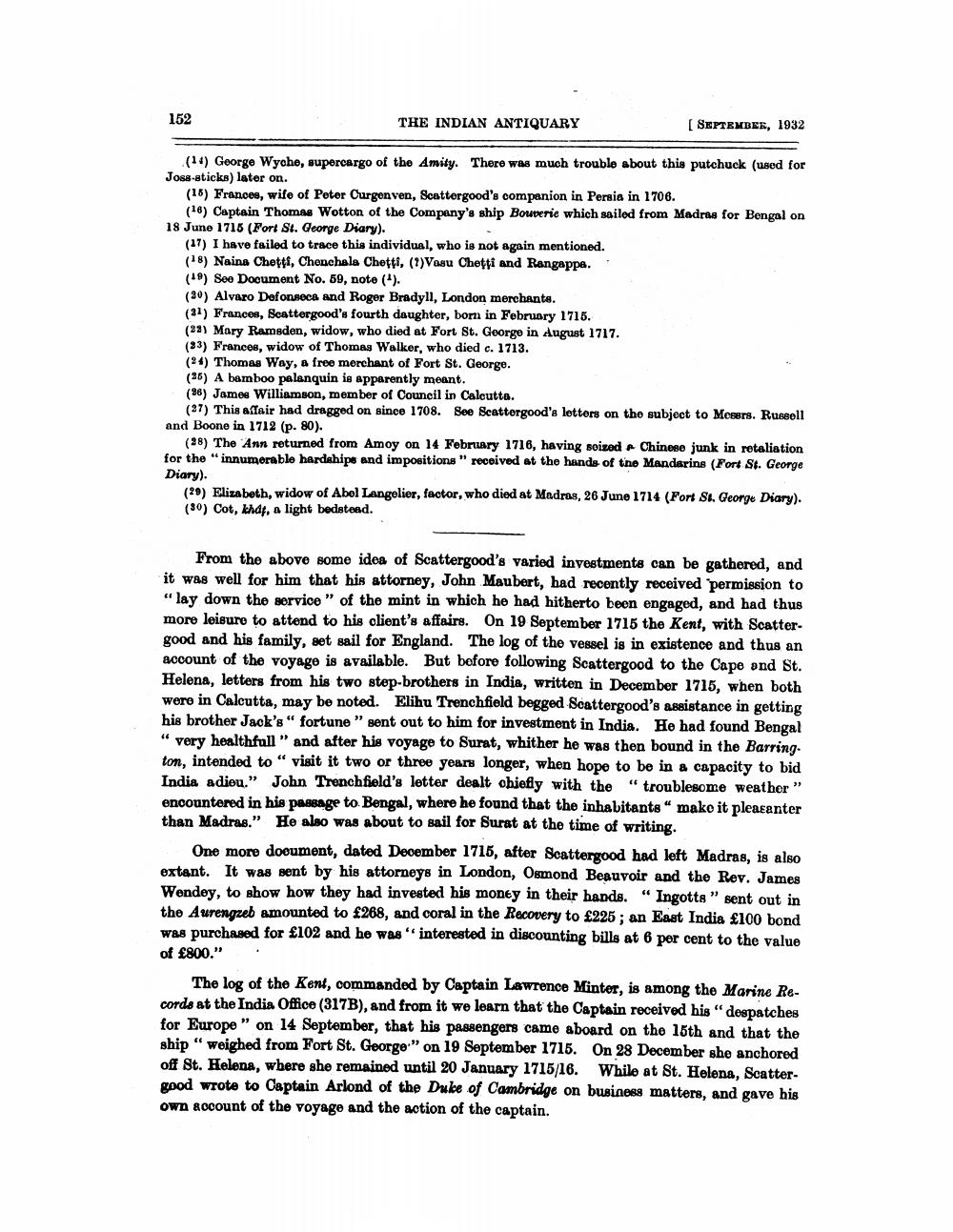________________
THE INDIAN ANTIQUARY
(14) George Wyche, supercargo of the Amity. There was much trouble about this putchuck (used for Joss-sticks) later on.
152
[ SEPTEMBER, 1932
(15) Frances, wife of Peter Curgenven, Scattergood's companion in Persia in 1706.
(16) Captain Thomas Wotton of the Company's ship Bouverie which sailed from Madras for Bengal on 18 June 1715 (Fort St. George Diary).
(17) I have failed to trace this individual, who is not again mentioned. (18) Naina Chetti, Chenchala Chetti, (?)Vasu Chetti and Rangappa. (19) See Document No. 59, note (1).
(20) Alvaro Defonseca and Roger Bradyll, London merchants.
(31) Frances, Scattergood's fourth daughter, born in February 1715.
(23) Mary Ramsden, widow, who died at Fort St. George in August 1717.
(33) Frances, widow of Thomas Walker, who died c. 1713.
(24) Thomas Way, a free merchant of Fort St. George.
(25) A bamboo palanquin is apparently meant.
(26) James Williamson, member of Council in Calcutta.
(27) This affair had dragged on since 1708. See Scattergood's letters on the subject to Messrs. Russell and Boone in 1712 (p. 80).
(28) The Ann returned from Amoy on 14 February 1716, having seized a Chinese junk in retaliation for the "innumerable hardships and impositions" received at the hands of the Mandarins (Fort St. George Diary).
(29) Elizabeth, widow of Abel Langelier, factor, who died at Madras, 26 June 1714 (Fort St. George Diary). (30) Cot, khdf, a light bedstead.
From the above some idea of Scattergood's varied investments can be gathered, and it was well for him that his attorney, John Maubert, had recently received permission to "lay down the service" of the mint in which he had hitherto been engaged, and had thus more leisure to attend to his client's affairs. On 19 September 1715 the Kent, with Scattergood and his family, set sail for England. The log of the vessel is in existence and thus an account of the voyage is available. But before following Scattergood to the Cape and St. Helena, letters from his two step-brothers in India, written in December 1715, when both were in Calcutta, may be noted. Elihu Trenchfield begged Scattergood's assistance in getting his brother Jack's " fortune" sent out to him for investment in India. He had found Bengal "very healthfull" and after his voyage to Surat, whither he was then bound in the Barring. ton, intended to" visit it two or three years longer, when hope to be in a capacity to bid India adieu." John Trenchfield's letter dealt chiefly with the "troublesome weather " encountered in his passage to Bengal, where he found that the inhabitants" make it pleasanter than Madras." He also was about to sail for Surat at the time of writing.
One more document, dated December 1715, after Scattergood had left Madras, is also extant. It was sent by his attorneys in London, Osmond Beauvoir and the Rev. James Wendey, to show how they had invested his money in their hands. "Ingotts" sent out in the Aurengzeb amounted to £268, and coral in the Recovery to £225; an East India £100 bond was purchased for £102 and he was "interested in discounting bills at 6 per cent to the value of £800."
The log of the Kent, commanded by Captain Lawrence Minter, is among the Marine Records at the India Office (317B), and from it we learn that the Captain received his "despatches for Europe" on 14 September, that his passengers came aboard on the 15th and that the ship" weighed from Fort St. George" on 19 September 1715. On 28 December she anchored off St. Helena, where she remained until 20 January 1715/16. While at St. Helena, Scattergood wrote to Captain Arlond of the Duke of Cambridge on business matters, and gave his own account of the voyage and the action of the captain.




